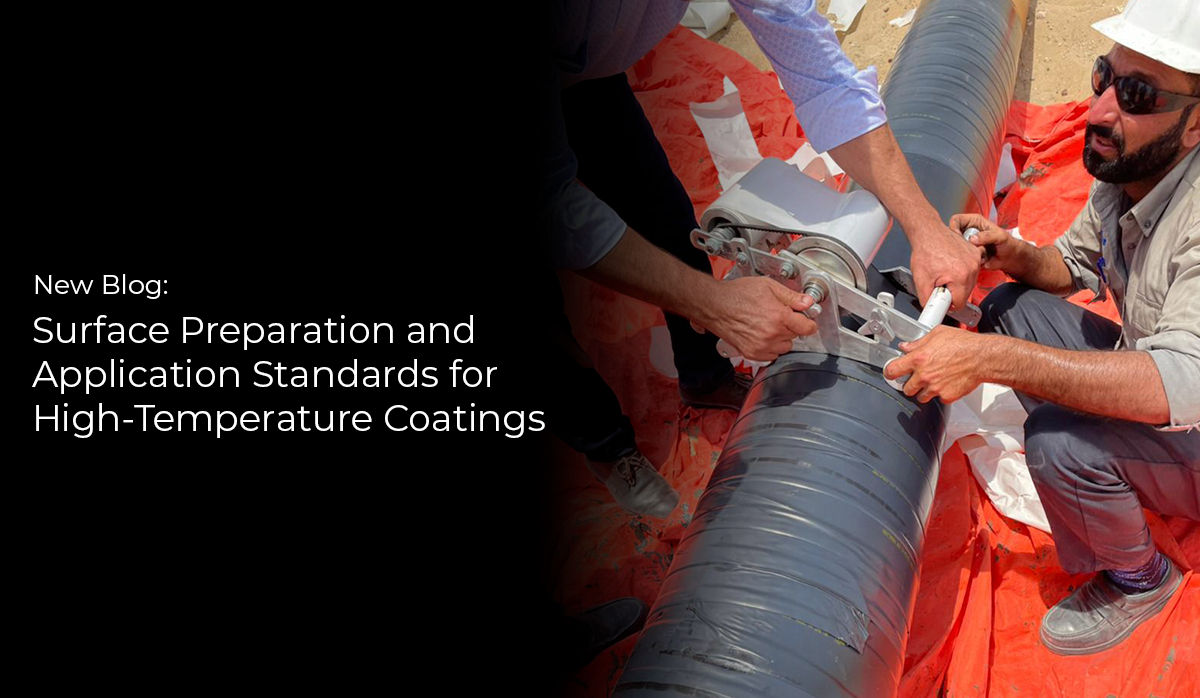High-temperature corrosion protection coatings are developed to meet the harsh environmental...
Surface Preparation and Application Standards for High-Temperature Coatings

It doesn't matter what kind of pipe you're working with, proper surface preparation is one of the most important factors in saving pipelines from the devastating consequences of tape failure. In part 2 of our series on High-Temperature Coatings, we'll discuss key components of surface preparation and application. If you missed our last post on the subject, you can find our benefits of corrosion-protecting high-temp coatings here.
Related Article: The Best Coatings for High Soil Stress
Importance of Surface Preparation
Corrosion protection coatings can be applied directly to properly prepared surfaces. Surface preparation can take various forms depending on the steel you're trying to treat. Surface preparation and cleaning can involve dirt, soil, oil, grease, chemicals, mill scale, rust paint, and many other contaminants.
Surface preparation is more than just cleaning. Surfaces must be diligently inspected and all defects or imperfections repaired. Surfaces may need additional profiling to ensure the face of the pipe is ready to properly adhere to the tape. In some cases, application of a primer is needed.
Any combination of these defects can affect your asset, so it's essential to follow a strict procedure to address each problem. Depending on the coating applied, surface preparation may include solvent wiping, hand tools, power tools, or commercial blasting. Refer to the manufacturer's written instructions and application guidelines for a complete list of instructions.
Surface preparation requirements may include language such as:
- Remove all dirt, oil, grease, salts, moisture, chemicals, and other contamination.
- Oil and grease shall be removed per SSPC SP-1.
- Abrasive blast rust areas to SSPC SP-10.
- Sweep blast to SSPC SP-7.
- Remove water-soluble salts to an undetectable level on areas blasted to SP-10.
When applying the near or over a water source,
- The area shall be entirely contained during blasting operations over water.
- No abrasive, old coating, rust, wash water, new coating, or any other material may be allowed to fall in the river.
SSPC and NACE Standards
Below is a table of commonly used SSPC and NACE standards in the pipeline industry that will aid your coating application. For the most current list of standards, visit https://www.sspc.org/wp-content/uploads/2020/01/Current-Active-Standards-June-2019.pdf
| SSPC/NACE Standard | Title | Description |
SSPC-SP 1 |
Solvent Cleaning | Solvent cleaning is intended to remove all visible oil, grease, soil, drawing and cutting compounds, and all other soluble contaminants from steel surfaces |
SSPC-SP 2 |
Hand Tool Cleaning | The removal of loose mill scales, loose rust, loose paint, and other loose detrimental foreign matter from surfaces with the use of non-powered hand tools |
SSPC-SP 3 |
Power Tool Cleaning | Removal of all loose rust, loose mill scale, and loose paint by power tool chipping, descaling, sanding, wire brushing, and grinding preparation |
SSPC-SP 5/
|
White Metal Blast Clean | A white metal blast to remove all coating, mill scale, rust oxides, corrosion products |
SSPC-SP 6/
|
Commercial Blast Cleaning | Removal of all visible rust, mill scale, paint, and foreign matter by blast cleaning. Staining is permitted on no more than 33% of each 9 in 2 (0.005 m2) area of the cleaned surface |
SSPC-SP 7 |
Brush Off Blast Clean | A brush of blast clean which allows as much of an existing adherent coating to remain as possible and to roughen its surface prior to coating application |
SSPC-SP 10/
|
Near-White Metal Blast Cleaning | Near-White Metal Blast Cleaning provides a greater degree of cleaning than commercial blast cleaning, but less than white metal blast cleaning |
SSPC-SP 11 |
Power-Tool Cleaning to Bare Metal | Similar to that of some less aggressive blast cleans, this standard requires the surface to be free from all visible oil, grease, dirt, dust, rust, coating, oxides, mill scale, corrosion products, and other foreign matter when viewed without magnification |
SSPC-SP 12 |
Surface Prep and Cleaning of Metals by Waterjetting Prior to Recoating | Water jetting is the use of standard jetting from a nozzle at high pressures (10,000 psi or higher) to prepare a surface for coating |
SSPC-SP 16 |
Brush-Off Blast Cleaning of Coated and Uncoated Galvanized Steel, Stainless Steel, and Non-Ferrous Metals | Use of this surface preparation standard roughens and cleans the bare substrate including a hot-dip galvanized coating to create a profile suitable for painting |
Several SSPC standard levels of cleanliness can be achieved by wet abrasive blast cleaning too.
Best Practices for a Successful Coatings Application
When selecting a high-temperature pipeline coating system, remember that some coatings are applied as a standalone coat while others may require a primer. Always consult the manufacturer’s product data sheet and abide by the written specifications. The requirement for additional primers may be necessary based on the temperature of the substrate. Lastly, most coating failures occur due to improper surface preparation. SSPC and NACE standards describe the various tools and materials required to achieve the proper surface profile. You may also find our guide on APWA pipe color coding standards helpful too.
Tapecoat and Royston tape coating systems provide corrosion protection to critical pipeline infrastructure. Our technical representatives can assist with product information to meet your coating needs. Please contact us.







